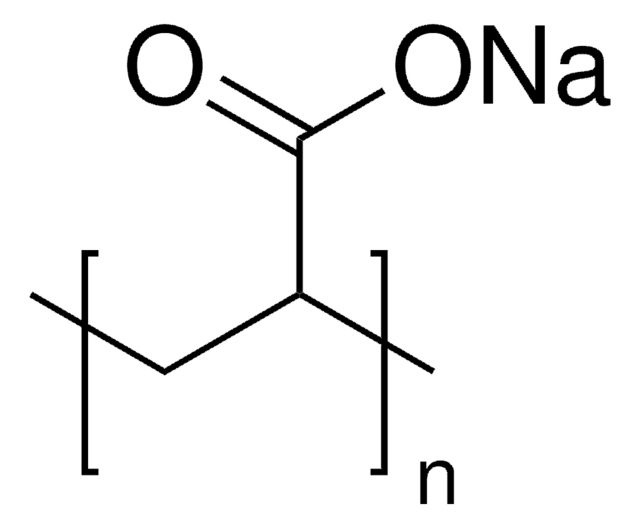181285
Ácido poliacrílico
average Mv ~450,000
Sinônimo(s):
PAA
About This Item
Produtos recomendados
reticulação
~0.1 % cross-linked
Nível de qualidade
peso molecular
average Mv ~450,000
viscosidade
350-2500 cP
temperatura de transição
Tg 106 °C
InChI
1S/C3H4O2.Na/c1-2-3(4)5;/h2H,1H2,(H,4,5);/q;+1/p-1
chave InChI
NNMHYFLPFNGQFZ-UHFFFAOYSA-M
Procurando produtos similares? Visita Guia de comparação de produtos
Descrição geral
Aplicação
Other applications may include:
- to study solute diffusion in Polyvinyl alcohol/PAA copolymer hydrogel
- synthesizing poly(N-isopropylacrylamide)-block-PAA copolymer which responds to both temperature and pH stimuli
- in preparing block copolymer of oligo (methyl methacrylate)/PAA for micellar delivery of hydrophobic drugs
- as thickening agent for adhesives.
Código de classe de armazenamento
11 - Combustible Solids
Classe de risco de água (WGK)
WGK 1
Ponto de fulgor (°F)
Not applicable
Ponto de fulgor (°C)
Not applicable
Escolha uma das versões mais recentes:
Já possui este produto?
Encontre a documentação dos produtos que você adquiriu recentemente na biblioteca de documentos.
Os clientes também visualizaram
Artigos
New methods for materials fabrication at the micro- and nanoscale will drive scientific and technological advances in areas of materials science, chemistry, physics, and biology. The broad diversity of potentially relevant materials, length scales, and architectures underscores the need for flexible patterning approaches. One important example is the fabrication of 3D periodic structures composed of colloidal, polymeric, or semiconductor5 materials.
Magnetic-plasmonic nanoparticles offer the combined benefits of both a magnetic probe as well as additional imaging modes usually associated with noble metal nanoparticles. Professor Shinya Maenosono (Japan Advanced Institute of Science and Technology) explores the synthesis, characterization, and proof-of-concept application of Ag/FeCo/Ag core/shell/shell magnetic-plasmonic nanobeads for imaging and isolation of cellular organelles (autophagosomes of COS-1 cells).
Nossa equipe de cientistas tem experiência em todas as áreas de pesquisa, incluindo Life Sciences, ciência de materiais, síntese química, cromatografia, química analítica e muitas outras.
Entre em contato com a assistência técnica


